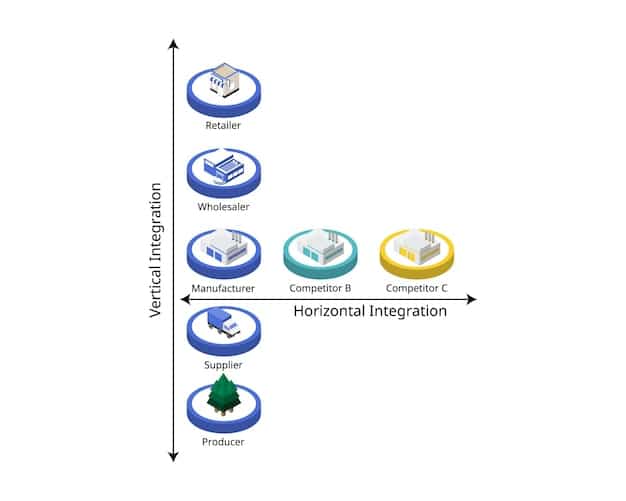US Government Launches Aid for Small Businesses Recovery

The U.S. government has unveiled a comprehensive new program designed to provide critical financial assistance and resources to small businesses struggling to recover from the recent economic downturn, aiming to stabilize local economies and preserve jobs across the nation.
In a significant move to bolster the nation’s economic landscape, the Government Announces New Program to Help Small Businesses Recover from Economic Downturn, offering a beacon of hope for countless enterprises grappling with ongoing challenges. This initiative aims to inject much-needed capital and support into the backbone of the American economy.
Understanding the Government’s New Recovery Initiative
The recent economic shifts have presented unprecedented hurdles for small businesses across the United States. Many have grappled with reduced consumer spending, supply chain disruptions, and the persistent challenge of adapting to a rapidly changing market. Recognizing these pervasive issues, the government has stepped forward with a multi-faceted program designed not just to alleviate immediate crises, but also to foster long-term resilience and growth within the small business sector. This recovery initiative extends beyond simple financial aid, encompassing a broader vision for economic stability.
At its core, this new program is built upon pillars of accessibility and strategic support. It acknowledges that a one-size-fits-all approach is often ineffective for the diverse needs of small businesses, which span a vast array of industries and geographical locations. Therefore, the framework includes various mechanisms tailored to specific types of challenges, from micro-enterprises to those with slightly larger operational footprints, ensuring that the aid reaches those who need it most effectively and efficiently.
Key Pillars of the Program
The program is structured around several crucial components, each designed to address a particular facet of small business recovery. These pillars represent a thoughtful approach to economic stimulus, focusing on both immediate relief and foundational improvements.
- 🚀 Direct Financial Assistance: Providing grants, low-interest loans, and revamped credit lines to inject immediate capital.
- 💡 Expert Advisory Services: Offering free or subsidized consulting for strategic planning, marketing, and digital transformation.
- 📚 Workforce Development Support: Assisting with training programs, retention incentives, and re-skilling initiatives for employees.
- 🔗 Supply Chain Resiliency: Programs aimed at diversifying and strengthening local and national supply chains.
Beyond these immediate actions, the initiative also emphasizes the importance of digital integration. Many small businesses found themselves ill-prepared for the rapid shift to online operations during the downturn. This program seeks to rectify that by subsidizing access to necessary technologies and providing training on e-commerce platforms, digital marketing, and cybersecurity best practices. This forward-looking aspect is crucial for ensuring businesses are better equipped for future economic fluctuations and competitive global markets.
Furthermore, the government’s announcement signals a commitment to transparency and ease of access. Applications are streamlined, and dedicated support channels are being established to guide business owners through the process. This attention to user experience is critical, as many small business owners often lack the time and resources to navigate complex bureaucratic systems. The goal is to make the relief as straightforward and impactful as possible, allowing businesses to focus on what they do best: serving their communities and driving economic activity.
Who is Eligible? Decoding the Criteria for Small Business Aid
Navigating government programs can often be a complex endeavor, and understanding the eligibility criteria is the first critical step for any small business seeking assistance. This new recovery initiative is no exception, but it has been designed with a conscious effort to broaden its reach while targeting those most in need. The specific criteria are multifaceted, considering factors like business size, revenue impact, and operational status during the downturn. Potential applicants should carefully review these guidelines to determine their suitability.
Generally, the program targets independently owned and operated businesses with a limited number of employees, typically ranging from fewer than 50 to 500, depending on the specific component of the aid. The definition of “small business” often aligns with the standards set by the Small Business Administration (SBA), but there may be nuances introduced by this new program. Furthermore, businesses must demonstrate a tangible negative impact from the recent economic challenges, often requiring documentation of revenue loss or increased operational costs. This evidence-based approach helps ensure that the aid is directed towards businesses genuinely struggling. It’s a proactive measure to prevent misuse of funds and to maximize the program’s overall effectiveness in stimulating recovery.
Certain industries that were disproportionately affected by the downturn are also receiving particular attention, though the program is broadly open to all sectors. This includes sectors like hospitality, retail, and certain service industries that experienced significant closures or reductions in capacity. The rationale here is to stabilize the parts of the economy that faced the hardest hits, acknowledging their vital role in local employment and community services. The government aims to foster an equitable recovery, recognizing that the economic impacts were not felt uniformly across all business types and regions.
Key Eligibility Factors
To simplify the application process, here are some common factors that will determine a business’s eligibility for various components of the program:
- 📊 Annual Revenue Thresholds: Businesses must typically fall within certain revenue limits, often varying by industry sector.
- 👥 Employee Count: Adherence to the Small Business Administration’s (SBA) definition of a small business based on headcount.
- 📉 Demonstrable Economic Impact: Proof of significant revenue loss, operational disruption, or increased costs during the downturn.
- 🏛️ Legal Business Registration: Must be a legally registered entity operating in the U.S. and in good standing.
Additionally, businesses must be able to provide clear documentation of their financial health, including tax records, profit and loss statements, and payroll information. The program emphasizes accountability and transparency, requiring businesses to attest to the accuracy of their application information. This rigorous approach is designed to build trust in the program and ensure that taxpayer money is used judiciously and effectively. While the process may seem stringent, it underscores the government’s commitment to supporting genuine recovery efforts across the small business community, acting as a steward of economic stability and growth.

Breaking Down the Benefits: Grants, Loans, and Technical Assistance
The newly announced government program for small businesses is not a monolithic offering but rather a comprehensive suite of benefits tailored to various needs. It wisely blends immediate financial relief with long-term strategic support, aiming to create a sustainable path to recovery. Understanding the different types of aid available—grants, loans, and technical assistance—is crucial for business owners to determine the best fit for their specific circumstances. Each component serves a distinct purpose in the broader recovery effort, addressing both the urgent and strategic challenges faced by enterprises.
Grants are perhaps the most immediately attractive form of assistance, as they do not require repayment. These funds are typically earmarked for specific purposes, such as covering operational expenses, retaining employees, or adapting business models to new market realities. The grant component is often competitive, with eligibility criteria focusing on businesses that can demonstrate severe economic hardship and a clear plan for utilizing the funds to sustain operations or prevent job losses. These direct injections of capital are invaluable for businesses teetering on the brink, offering a lifeline without adding to their debt burden. The emphasis is on swift deployment and measurable impact.
In contrast, loans offer a different kind of financial leverage. The program introduces new low-interest loan options and, in some cases, expands existing government-backed loan programs. These loans are designed for businesses that need significant capital for growth, expansion, or a more extensive overhaul of their operations, with the capacity to repay over time. The favorable terms, including reduced interest rates and extended repayment periods, make them a more accessible option than traditional commercial loans, especially for businesses with challenging credit histories exacerbated by the downturn. The government acts as a guarantor or direct lender, mitigating risk for both parties and channeling essential funds into the economy. This support is crucial for businesses aiming to rebuild and invest in their future, providing the necessary liquidity to innovate and adapt.
Diverse Support Channels
Beyond direct financial aid, the program also heavily emphasizes technical assistance, recognizing that capital alone may not be sufficient for a full recovery. This includes:
- 🌐 Digital Transformation Workshops: Training on e-commerce platforms, social media marketing, and online customer engagement.
- 🤝 Business Mentorship Programs: Connecting experienced entrepreneurs with struggling business owners for guidance and advice.
- ⚖️ Legal and Regulatory Consulting: Assistance with navigating new compliance requirements and understanding legal obligations.
- 📊 Financial Management Training: Courses on budgeting, cash flow management, and effective use of financial resources.
This technical assistance is often delivered through partnerships with local Chambers of Commerce, Small Business Development Centers (SBDCs), and non-profit organizations that specialize in business support. The goal is to empower business owners with the knowledge and skills necessary to not only survive but thrive in the evolving economic landscape. By providing a holistic package of financial and educational resources, the government aims to create a stronger, more resilient small business sector, capable of weathering future economic storms and contributing robustly to national prosperity. This integrated approach ensures that businesses receive not just a handout, but a hand up, equipped with the tools for sustained success.
Application Process: A Step-by-Step Guide for Small Business Owners
The journey to accessing government aid can often seem daunting, but the architects of this new recovery program have made concerted efforts to streamline the application process. A clear, step-by-step guide is now available, aiming to demystify the requirements and accelerate the disbursement of funds. For any small business owner considering applying, understanding this pathway is paramount to a successful outcome. The emphasis has been placed on clarity and support, ensuring that even those with limited experience in grant or loan applications can navigate the system effectively.
The initial phase typically involves an online pre-application or eligibility check. This foundational step allows businesses to quickly ascertain if they meet the basic criteria before investing significant time in a full application. This digital gateway asks a series of targeted questions related to business structure, employee count, and the financial impact experienced during the downturn. Should a business pre-qualify, it then proceeds to the main application portal, which serves as a centralized hub for submitting all necessary documentation. This approach saves valuable time for both applicants and program administrators, making the process more efficient for everyone involved.
Essential Application Steps
Here’s a breakdown of the typical stages involved in applying for assistance:
- 📝 Eligibility Assessment: Complete an initial online questionnaire to confirm your business meets basic program requirements.
- 📄 Document Gathering: Collect all financial statements, tax returns, payroll records, and legal registrations.
- 💻 Online Application Submission: Fill out the detailed application form through the designated government portal.
- 📞 Follow-Up and Verification: Be prepared for potential inquiries from program officers to clarify information or provide additional documents.
Required documentation will invariably include financial statements (profit and loss statements, balance sheets), recent tax returns, payroll records to verify employee numbers, and legal business registration documents. It is highly advisable for business owners to gather these documents in advance to avoid delays. Moreover, the program encourages applicants to be meticulous in providing accurate and complete information, as omissions or errors can significantly prolong the review process or lead to rejection. The government emphasizes the importance of transparency and accuracy in all submissions, as it underpins the integrity of the entire program and ensures fair distribution of funds across the nation.
Alongside the digital application, many local Small Business Development Centers (SBDCs) and Chambers of Commerce are offering free assistance for completing applications. These organizations provide invaluable hands-on support, including guidance on documentation, understanding the nuances of certain questions, and troubleshooting any technical issues with the online portal. This local support network is a critical component of the program’s success, ensuring that even businesses in remote areas or those without extensive administrative resources can successfully access the aid they need. The proactive outreach and support services are a testament to the government’s commitment to reaching all eligible small businesses.

Economic Impact: How Small Businesses Drive National Recovery
The phrase “small businesses are the backbone of the economy” is more than just a cliché; it’s a fundamental truth, particularly relevant in times of economic recovery. The newly announced government program recognizes this crucial role, understanding that direct support to small enterprises translates into broader economic stabilization and growth. By empowering these businesses, the initiative aims to catalyze a ripple effect that extends far beyond individual companies, fostering job creation, local investment, and comprehensive national recovery. The health of the small business sector is intricately linked to the overall economic robustness of the nation, making their recovery a priority.
Small businesses are disproportionately responsible for job creation in the United States. When they expand, rehire, or simply avoid layoffs, they directly contribute to reducing unemployment rates and increasing household incomes. This renewed employment directly stimulates consumer spending, which in turn fuels demand for goods and services, creating a virtuous cycle of economic activity. The financial aid provided through grants and loans helps them maintain payrolls, invest in new equipment, or expand their offerings, thus solidifying job security and fostering new opportunities. The program’s success is measured not just in disbursed funds, but in the sustained jobs and livelihoods it protects and creates.
Moreover, small businesses are often deeply embedded in their local communities, acting as essential service providers, employers, and cultural hubs. Their recovery means the revitalization of Main Streets, the flourishing of local economies, and the preservation of unique community identities. When a local bakery or hardware store thrives, it benefits the entire neighborhood through increased local spending, property values, and a stronger sense of community. The government’s program implicitly supports this local ecosystem, acknowledging that a strong national economy is built from the ground up, starting with healthy local commerce and vibrant neighborhood businesses.
Multiplier Effect of Small Business Support
The support offered to small businesses generates significant positive economic outcomes, known as the multiplier effect:
- 📈 Increased Employment: Direct job creation and retention, leading to lower unemployment rates.
- 💰 Boosted Local Spending: Thriving businesses mean more local investment and consumer purchases, circulating money within communities.
- 🛡️ Enhanced Economic Resilience: A diverse small business sector makes the overall economy less susceptible to shocks.
- Innovations and New Services: Small businesses are often incubators for innovation, introducing new products and solving local problems.
The investment in small businesses through this program is therefore not merely a bailout but a strategic investment in the nation’s future economic stability and prosperity. By providing the tools for recovery and growth, the government is essentially laying the groundwork for a more robust and equitable economy. The long-term vision is an economy less prone to severe downturns, where small enterprises are resilient, innovative, and continue to be engines of growth and opportunity for all Americans. This holistic approach to economic development positions small businesses at the forefront of a sustainable recovery, showcasing their indispensable role.
Challenges and Criticisms: Addressing Implementation Hurdles
While the government’s new recovery program for small businesses offers significant promise, it would be disingenuous to ignore the inherent challenges and criticisms that often accompany such large-scale initiatives. No program of this magnitude is entirely without its hurdles, and a clear-eyed assessment of potential pitfalls is essential for effective implementation and continuous improvement. Understanding these difficulties allows for proactive adjustments and helps manage expectations among the small business community. The success of the program hinges not only on its design but also on its adaptive capacity to address real-world complexities and feedback from stakeholders.
One primary criticism often revolves around the speed and efficiency of fund disbursement. Small businesses, particularly those facing immediate liquidity challenges, require rapid access to aid. Bureaucratic processes, however well-intentioned, can sometimes lead to delays, potentially undermining the program’s intended impact. Concerns about paperwork burden and the complexity of application requirements have also been raised, especially for micro-businesses that may lack dedicated administrative staff. The government’s efforts to streamline the process are commendable, but ongoing vigilance is needed to ensure these improvements are effective in practice, rather than just in theory. Transparency in tracking funds and outcomes also remains a key area for public scrutiny and accountability.
Another area of concern is equitable access. While the program aims to be inclusive, there are valid questions about whether businesses in underserved communities or those owned by minorities and women will receive their fair share of the aid. Historical data from previous relief efforts sometimes indicates disparities in access, where larger or more connected businesses might disproportionately benefit. Addressing these potential biases requires targeted outreach, culturally sensitive support services, and proactive monitoring of distribution metrics to ensure that the aid reaches all segments of the small business community. The program must actively work to dismantle barriers to access, ensuring that its benefits are truly universal.
Common Challenges in Program Rollout
- 🐌 Bureaucratic Delays: Slow processing times impacting businesses with urgent needs.
- 🤷 Complexity of Application: Overwhelming paperwork for small businesses lacking dedicated administrative resources.
- ⚖️ Equitable Access: Ensuring fair distribution of aid to all demographics, especially underserved communities.
- 📊 Tracking and Accountability: The difficulty in transparently monitoring the use of funds and measuring real impact.
Furthermore, the long-term effectiveness of the technical assistance components will depend on the quality of the resources provided and the engagement of the business owners. Merely offering workshops and mentorship is not enough; these services must be highly relevant, practical, and delivered by credible experts. Measuring the impact of such soft interventions can be more challenging than tracking financial disbursements. Continuous feedback loops from participants and regular evaluations of service providers will be critical to ensuring that the technical assistance genuinely empowers businesses for sustainable growth. The government’s commitment extends beyond launching the program, demanding an ongoing dedication to refinement and responsiveness to ensure its ultimate success and widespread benefit.
Looking Ahead: Long-Term Vision for Small Business Resilience
The government’s new recovery program is not merely a short-term response to an economic downturn; it embodies a broader, long-term vision for enhancing the resilience and adaptability of the small business sector. This forward-thinking approach recognizes that economic stability is best achieved through proactive strategies that equip businesses to navigate future challenges, rather than simply reacting to crises. The initiative aims to lay a robust foundation for enduring economic health, focusing on structural improvements and fostering an environment conducive to sustainable growth. This kind of strategic planning is paramount for creating an economy that is not only robust but also capable of quick recovery from unforeseen global events.
A key element of this long-term vision is the promotion of innovation and digital transformation. The program’s emphasis on technical assistance for e-commerce, cybersecurity, and data analytics is designed to future-proof small businesses, making them more competitive in an increasingly digital world. By facilitating access to modern technologies and relevant skills training, the government aims to bridge the digital divide that many small enterprises faced during the recent shifts. This proactive investment ensures that businesses are not only recovering from past setbacks but are also being prepared for the technological demands of tomorrow’s marketplace, fostering a culture of continuous adaptation and technological prowess.
Furthermore, the program seeks to strengthen local and national supply chains. The vulnerabilities exposed during the downturn highlighted the need for greater diversification and greater regional reliance. Through incentives and advisory services, the government is encouraging small businesses to explore local sourcing options and to participate in more resilient supply networks. This focus reduces dependency on volatile international markets and creates a more stable operational environment for domestic businesses. A robust supply chain network is a critical component of national economic security, ensuring that essential goods and services remain available even during periods of global disruption.
Strategies for Enduring Strength
The long-term vision includes several key strategies to build small business resilience:
- 🌱 Fostering Innovation: Encouraging technological adoption and R&D within small enterprises.
- 🌍 Diversifying Supply Chains: Promoting local and regional sourcing to reduce global dependencies.
- 🧑🏫 Continuous Skill Development: Providing ongoing training for owners and employees to adapt to market changes.
- 🤝 Strengthening Business Networks: Encouraging collaboration and peer-to-peer support among small businesses.
Finally, the long-term vision includes fostering a stronger ecosystem of support for small businesses, extending beyond government aid. This involves encouraging partnerships between educational institutions, financial lenders, and private sector mentors to create a sustained network of resources. The government’s role is not just to provide funds but to act as a catalyst for these broader collaborations, ensuring that small businesses have access to advice, capital, and talent long after this specific recovery program concludes. Ultimately, this holistic approach aims to cultivate a dynamic and antifragile small business sector, capable of driving sustained prosperity and innovation for generations to come, embodying a proactive stance to economic development.
| Key Program Aspect | Brief Description |
|---|---|
| 💰 Financial Aid | Offers grants and low-interest loans to cover operational costs and foster growth. |
| 🛠️ Technical Support | Provides expert advice, training, and resources for strategic and digital transformation. |
| 🎯 Eligibility Focus | Targets businesses with demonstrable economic impact and specific size/revenue criteria. |
| 📈 Economic Impact | Aims to revitalize local economies, boost job creation, and ensure long-term stability. |
Frequently Asked Questions About the Small Business Recovery Program
The program mainly offers two forms of financial aid: non-repayable grants, typically for immediate operational expenses or job retention, and low-interest loans designed for longer-term growth, expansion, or significant business overhauls. Eligibility for each depends on specific criteria and demonstrable need.
Eligibility is based on factors such as business size (employee count and annual revenue, often per SBA standards), proof of negative economic impact from the downturn, and current operational status. An initial online assessment tool is available to guide businesses through the preliminary qualification process.
Technical assistance includes free or subsidized consulting in areas like digital transformation, e-commerce, marketing, and financial management. Workshops, mentorship programs, and legal guidance are also provided, often in partnership with local business support organizations to enhance long-term resilience.
Small businesses are crucial for recovery by being primary drivers of job creation and local economic activity. Their stability ensures continued employment, stimulates consumer spending, and revitalizes communities, creating a positive ripple effect throughout the national economy.
Common challenges include potential delays in fund disbursement due to bureaucratic processes, the complexity of application requirements for very small businesses, and ensuring equitable access for all, particularly underserved communities. The government aims to mitigate these through streamlined processes and targeted outreach.
Conclusion
The government’s announcement of a new program to help small businesses recover from the economic downturn marks a pivotal moment for the nation’s economic future. By combining direct financial aid with strategic technical assistance, the initiative offers a comprehensive lifeline to the enterprises that form the bedrock of local communities and national prosperity. While implementation will naturally present challenges, the proactive measures and long-term vision embedded in this program underscore a strong commitment to fostering resilience and sustainable growth. The success of this endeavor will hinge on effective outreach, streamlined processes, and continuous adaptation, ultimately paving the way for a more robust and equitable economic landscape across the United States for years to come.





